Avete mai provato ad aprire uno dei vostri post su WordPress per poi essere accolti da un errore 404? A volte ci capita quando lavoriamo sui nostri siti WordPress o aiutiamo i nostri utenti a risolvere il problema.
Questo errore si verifica quando si riesce ad accedere all’area di amministrazione di WordPress e al blog, ma quando si cerca di aprire un post specifico, viene visualizzato il messaggio “404 Not Found”.
Può essere frustrante vedere i propri contenuti apparentemente scomparire, ma abbiamo trovato alcune soluzioni per risolvere questo problema. In questa guida completa, vi mostreremo come risolvere i post di WordPress che restituiscono errori 404.

Perché gli articoli di WordPress restituiscono un errore 404?
Ci sono diversi motivi per cui i vostri post potrebbero mostrare un errore 404 “Pagina non trovata” in WordPress. Questi possono essere:
- Conflitti tra plugin o temi: A volte, i plugin o i temi installati sul sito possono interferire con il modo in cui WordPress gestisce i permalink. Ciò può causare la rottura dei colleghi e la comparsa di errori 404.
- Problemi di codice personalizzato: Se avete aggiunto del codice personalizzato al vostro sito web, potrebbero esserci errori nel codice che influenzano i permalink o causano altri conflitti, con conseguenti errori 404 per gli articoli.
- Problemi con il file .htaccess: Il file .htaccess svolge un ruolo nel modo in cui WordPress struttura gli URL. Se questo file è danneggiato o mancante, può causare errori 404 per i post o le pagine.
Come trovare tutti i post di WordPress con errori 404
Prima di passare alle soluzioni, sarebbe bene capire se l’errore si verifica solo in uno o due post o in più post. In questo modo, è possibile determinare la portata del problema e scegliere la soluzione più appropriata.
Un modo semplice per scoprirlo è utilizzare Google Search Console. Se non avete ancora inviato il vostro sito a Google Search Console, leggete la nostra guida su come aggiungere il vostro sito WordPress a Google Search Console.
Una volta che il bot di Google ha effettuato il crawling e l’indicizzazione del vostro sito, Google Search Console vi fornirà informazioni dettagliate sulle prestazioni del vostro sito, compresi gli errori 404 che incontra.
Per scoprire quali post restituiscono errori 404, è possibile accedere alla dashboard di Search Console. Quindi, navigate nel report “Pagine” e vedrete un elenco dettagliato di tutti gli errori.
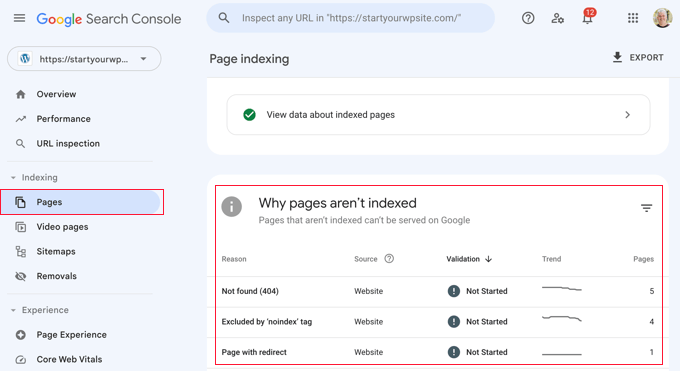
Per ulteriori informazioni, potete leggere il nostro elenco di suggerimenti per l’utilizzo di Google Search Console per aumentare il traffico del sito web, che include alcuni consigli su come risolvere gli errori 404 con lo strumento.
Detto questo, vediamo come correggere gli articoli di WordPress che restituiscono errori 404. Potete usare i colleghi qui sotto per passare direttamente alle diverse soluzioni:
Non avete tempo di risolvere da soli gli errori 404? I Servizi Pro di WPBeginner possono aiutarvi! Con la nostra conveniente Assistenza WordPress d’emergenza, potete assumere esperti per risolvere errori 404, link rotti, problemi di reindirizzamento e molto altro. Smettete di stressarvi per i problemi di WordPress e correggeteli! Programmate oggi stesso un servizio di assistenza WordPress di emergenza!
Metodo 1: Verificare la presenza di conflitti tra plugin o temi e problemi di codice personalizzato
A volte, i plugin, i temi o il codice personalizzato che avete aggiunto al vostro sito WordPress possono interferire con i permalink o causare conflitti, causando errori 404. Lo abbiamo sperimentato anche noi quando stiamo testando gli strumenti sul nostro sito demo.
Un modo per risolvere questo problema è disattivare temporaneamente i plugin. I plugin possono talvolta disturbare il modo in cui WordPress gestisce i colleghi.
Una volta disattivati i plugin, è possibile riattivarli uno per uno, selezionando se l’errore 404 ricompare dopo aver attivato ciascun plugin. Se l’errore compare dopo aver attivato un plugin specifico, il colpevole potrebbe essere quello.
È quindi possibile effettuare una rapida ricerca su Google per trovare soluzioni relative a quel plugin o contattare lo sviluppatore del plugin per ottenere assistenza.
Allo stesso modo, il tema di WordPress potrebbe essere la causa del conflitto.
Per selezionare, è possibile passare temporaneamente a un tema predefinito di WordPress, come Twenty Twenty-Three o Twenty Twenty-Four. Basta andare in Aspetto “ Temi e fare clic su ‘Attiva’ su un tema predefinito.

Se l’errore 404 scompare con il tema predefinito, ciò indica un potenziale conflitto con il tema corrente. Si può quindi provare a risolvere il problema del tema o prendere in considerazione l’utilizzo di un tema diverso.
Potete consultare la nostra selezione di esperti dei temi WordPress più popolari per avere consigli.
Se di recente avete inserito degli snippet di codice nel vostro sito web, potrebbero esserci degli errori nel codice che causano l’errore 404. Esaminate attentamente il codice che avete aggiunto e vedete se riuscite a individuare qualche errore.
Il modo più sicuro per aggiungere frammenti di codice a WordPress è il plugin WPCode. Questo plugin consente di inserire codice personalizzato senza intervenire direttamente sui file del tema, riducendo il rischio di rottura del sito web.
Inoltre, ogni volta che WPCode individua un errore nel codice, disattiva automaticamente lo snippet e chiede di selezionarlo. È anche possibile utilizzare la modalità di test per verificare se il codice funziona prima di inviarlo al sito web.

Se nessuna di queste soluzioni funziona, passate al metodo successivo, che prevede la risoluzione dei problemi relativi alle impostazioni dei permalink.
Metodo 2: correggere le impostazioni dei permalink
Gli articoli di WordPress possono restituire errori 404 a causa di problemi con le regole di riscrittura nel file .htaccess. Nella maggior parte dei casi, è possibile correggere il problema aggiornando le impostazioni dei permalink.
Basta andare su Impostazioni ” Permalinks nell’amministrazione di WordPress e fare clic sul pulsante “Salva modifiche”.

Non è necessario modificare le impostazioni dei permalink. Questa operazione aggiornerà le impostazioni dei permalink e cancellerà le regole di riscrittura.
Nella maggior parte dei casi, questa soluzione corregge l’errore 404 degli articoli di WordPress. Tuttavia, se non funziona, probabilmente è necessario aggiornare manualmente il file .htaccess.
Metodo 3: Aggiornamento del file .htaccess di WordPress
Prima di iniziare, assicuratevi di eseguire un backup del file .htaccess di WordPress. Se qualcosa dovesse andare storto, potrete facilmente ripristinare il file originale.
A questo punto, è necessario connettersi al server utilizzando un client FTP come FileZilla o l’applicazione File Manager nella dashboard del vostro hosting WordPress.
Successivamente, dovrete trovare e modificare il file .htaccess, che si trova nella stessa posizione di cartelle come /wp-content/ e /wp-includes/.
È sufficiente fare clic con il tasto destro del mouse sul file e selezionare “Autorizzazioni file”.
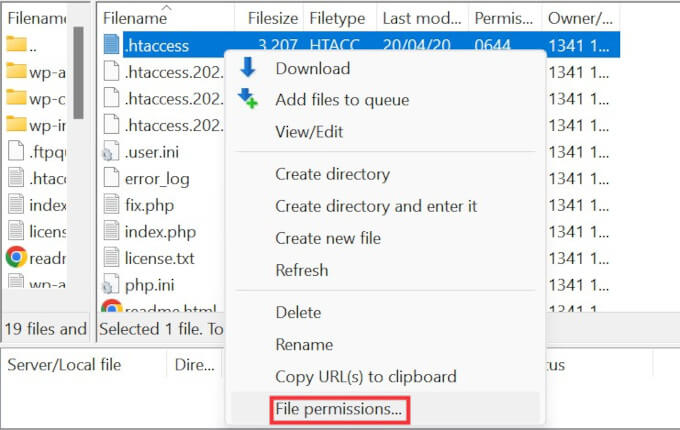
È possibile rendere il file scrivibile cambiando le autorizzazioni a 666.
Inserite semplicemente “666” nella casella “Valore numerico” e fate clic su “OK”.

Quindi, è necessario ripetere i passaggi del primo metodo del nostro tutorial. Una volta fatto questo, non dimenticate di modificare le autorizzazioni in 660.
È anche possibile modificare il file e aggiungervi del codice.
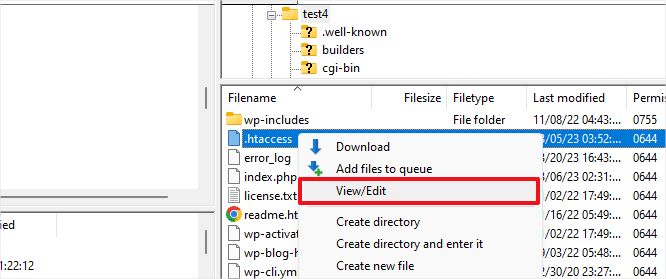
Una volta aperto il file .htaccess con un editor di testo, è sufficiente inserire questo codice:
# BEGIN WordPress
<IfModule mod_rewrite.c>
RewriteEngine On
RewriteBase /
RewriteRule ^index\.php$ - [L]
RewriteCond %{REQUEST_FILENAME} !-f
RewriteCond %{REQUEST_FILENAME} !-d
RewriteRule . /index.php [L]
</IfModule>
# END WordPress
Metodo 4: contattare il fornitore di hosting
Se nessuna delle soluzioni sopra descritte ha corretto l’errore 404 degli articoli di WordPress, vi consigliamo di contattare il vostro fornitore di hosting WordPress. Potrebbe trattarsi di un errore on loro, oppure potrebbero aiutarvi a risolvere il problema.
NON SI TRADUCE la nostra guida su come richiedere correttamente l’assistenza WordPress e ottenerla.
Metodo 5: Abilitare il mod-rewrite (installazione locale di WordPress)
Se si utilizza un server locale a scopo di test, è necessario abilitare il mod_rewrite nella configurazione Apache del sito MAMP, WAMP o XAMPP.
Questo permetterà a WordPress di generare URL puliti e di evitare l’errore 404 per articoli e pagine sul server locale.
Il modo in cui farlo varia a seconda della piattaforma utilizzata. Chi usa XAMPP può aprire il proprio pannello di controllo e fare clic sul pulsante “Config” all’interno di Azioni. Quindi, selezionare “Apache (httpd.conf)”.
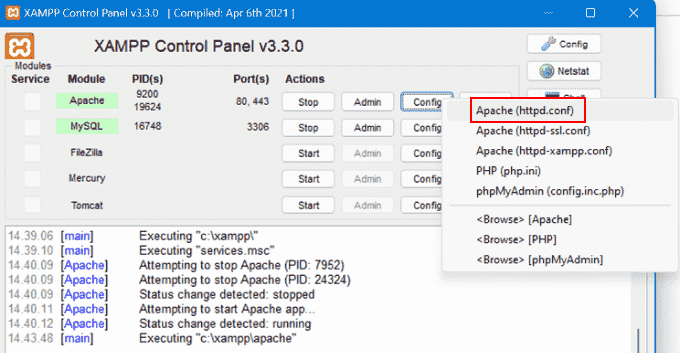
Successivamente, è necessario trovare questa riga #LoadModule rewrite_module modules/mod_rewrite.so e rimuovere il ‘#’ per decommentarla.
Questo caricherà il mod_rewrite.
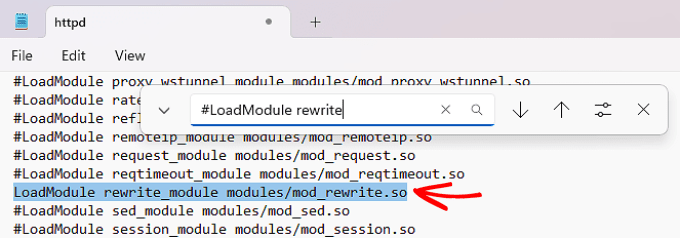
Quindi, individuare tutte le istanze di AllowOverride None e modificarle in AllowOverride All.
Il valore “Tutti” significa che tutte le direttive possono essere sovrascritte.

Una volta fatto, si può salvare il file httpd.conf e chiuderlo. Dopodiché, nel pannello di controllo di XAMPP, fate clic su ‘Stop’ sul modulo Apache e su ‘Start’ per riavviarlo.
Poi, tornate alla vostra Bacheca per vedere se i permalink funzionano.
Video tutorial
Se avete bisogno di istruzioni visive, guardate il video qui sotto.
Speriamo che questo articolo vi abbia aiutato a risolvere i post che restituiscono errori 404 in WordPress. Potreste anche voler consultare la nostra guida agli errori più comuni di WordPress e a come risolverli, insieme alle scelte dei nostri esperti sui migliori plugin WordPress per far crescere il vostro sito.
Se questo articolo vi è piaciuto, iscrivetevi al nostro canale YouTube per le esercitazioni video su WordPress. Potete trovarci anche su Twitter e Facebook.





Larry
Hi,
I have moved my two domains from a web hosting service provider to another web hosting service provider. The new web hosting service provider setup WordPress websites from the cPanel. Only the homepages are loading correctly but the other webpage links are showing Server Error 404 Page Not Found.
The webhosting service provider told me to update my permalinks and the web.config code. I updated the permalinks to show “post name”. I don’t know how to update the web.config code. From watching these videos, I see that I should update the htaccess file. However, my htaccess do not show any missing text and it contains identical as shown in your video. What next should I do?
Many thanks.
Joe
My problem is, I moved my blog to a self host. And changed my permalink to “post name” Ever since then,
1. I noticed my traffic start reducing,
2. Couldn’t get searches from Google/yahoo/bing linking to my blog again.
3. Got a lot of broken links.
What do I do please?
I’ve started getting discouraged with this..
WPBeginner Support
Hi Joe,
You can change your permalink structure to whatever it was before by visiting Settings » Permalinks page.
Admin
David
Thank you very much! This tutorial was very helpful.
Bert Ramirez
Worked like charm…THANK YOU!!
Tejash
Thanks so much. I was able to resolve the error
prakhar
when i try to see plugins it gives 404 error.
add plugin is working fine but i can’t get to plugin.php when i try to see
installed plugins.
also update-core.php also gives 404 error.
what could be the reason?
jeff
Hi,
I have the same problem. I couldnt able to install a plugin which is this “themify-wc-product-filter.zip” .i always get file not found error 404 as result. can anyone help me out please? thanks guys in advance
Marisol
Hey thank you work for me took me 2 minutes to fix it!
Sjoerd
Hi,
I have the same problem. The first solution worked for me, just now wordpress somehow keeps getting back tot the 404.
So i click save changes, it works again. And then a few minutes later the 404 error is back. Anyone any ideas?
Thanks.
Kind regards,
Sjoerd
Ravi J
I have the same issue too….
1) Changed Permalink
2) Manullay created the .htaccess file
3) removed and created the site once again
Amy help is greatly appriciated
Note: I am setting up a local instance in Ubuntu 16 LTS.
Biggles
I have a similar problem: I moved hosting providers and now my WP login box is top left hand corner of my browser screen and, most critically, when I login, every page and link for WP gives me a 404.
The website loads fine for my visitors but I am unable to gain access myself in WP. Well, I am, I can log in, but that’s all I am able to do. After many years of web design, this is a first.
I have done the following:
1. deleted the .htaccess file
2. tried an old .htaccess file
3. created a new .htaccess file
4. changed the name of some and all of the plugin folder names via ftp to see if there’s an issue with a plugin
FYI, that I was unable to load my sample website (subdomain) after the migration, and all that was showing was a ‘database error’ white screen. I finally managed to track down the issue, and I was a little bit upset about it: in my new cPanel, I noticed the username had disappeared next to the database name, and when I tried re-entering it again it wouldn’t take it because I had been limited to only a few characters in length. I created a new username and updated the config file, and it works okay now.
So, I opened my new cPanel and my previous cPanel side by side and my old host didn’t restrict me on database username character length, whereas my new host did to about 7 or 8.
…so, I’m starting to think that even though all of my other subdomains and client websites are now all loading fine, that it may be that a different version of cPanel and how my new hosting provider has set it up has affected how I interact in WP for my failing website.
v. 68.0.23 new cPanel
v. 66.0.34 old cPanel
Do you think there is an issue with how my new host has setup WHM and / or cPanel.
Many thanks in advance : )
Wen
Hi there, i did other test and the error show everytime, so any ideas??
Afroze
for me, after going nuts, i had to enable the rewrite module… i forgot to do this when I migrated sites.
in ubuntu:
sudo a2enmod rewrite
Wen
Hi guys!
I’ve tried everything and its shows still the error in my links, can you help me?
WPBeginner Support
Hi Wen,
If you are seeing 404 errors on just few pages, then you can try setting up redirects to fix them.
Admin
Wen
The problem is in all the links except the home…. and i did everything except redirect…
Hank Wilson
Thanks for this, permalinks idea worked. Bookmarked for future reference
Alan Ross
Thanks for the fix. Worked like a charm !
Fahad Siddiqui
I tried this .htaccess code but the error remains same as “Not Found
The requested document was not found on this server.”
TJ
I am wondering if this would fix my admin login page? Keeps showing 404 error and not the login page. I don’t have issues with a 404 error on pages and post. I think it might be conflicting plugin I’m using called Hide MyWp, but they told me its working and reset the settings anway and said it’s beyond their plugin control.
WPBeginner Support
Hi TJ,
Try steps mentioned in our WordPress troubleshooting guide. It will help you figure out what’s causing the issue and how to fix it.
Admin
LaVonne Carlson
Thank you! This worked for me. I did have to change the Common Settings from “Custom Structure” to “Post name”, but once I did that my blog came back.
Nick
I followed your instructions, but I still get the “white page of death” with my posts. Is there a way to actually remove “index.php”?
WPBeginner Support
Hi Nick,
The index.php file is crucial for your WordPress site to work properly. If you think it is causing the issue, then you can download a fresh copy of WordPress, unzip on your computer, locate the index.php file and upload it to your website replacing the old file.
Admin
Malik aadil
Thanks so much
It helped me to solve 404 error problem
srinivas
i dont know how to thank you…it really helps and solved my problem…thanks ….lovely post
Demari
Thank you so much for this!
Christina
Thank you very much! Your help solved the problem!
Rafi ullah
Hi every one..
i have a website which is working properly but when i login to admin panel and want to edit a page it show me a error that “page not found” but in the front end it look fine this error show only on editing time ..
please help me i am stuck
Thanks in advance
Jeremy
THANK YOU SO MUCH! I’ve tried everything else thinking it was a timing error. You saved me lots of time.
Thank you again!
Serguei Kireev
didn’t work for me. installed Yoast SEO, noticed it defaulted to weird permalinks with /index.php/ in them, went to change that to normal way – no more permalinks for me… only works via ?p=123
mudi
Hi, you guys are great it’s work for me
elham
Thank you so much!!!!
Vikash
Thanks, Its worked perfectly.
Karen Holst
You guys are the best!
I always find your tutorials to be just what I need to update/fix my WordPress site!
Regarding the 404 not found issues, I had some template pages (I purchased a WordPress theme from a vendor and had some live pages hidden that I wasn’t using) that were getting indexed that I didn’t want indexed. So I changed the pages to “unpublished” in WordPress.
I ran an analysis on indexability and now all those pages are showing “404 Not Found” errors.
Do you all suggest a way to keep these pages from being indexed altogether? What is the best practice for fixing something like this?
Thank you again for all the great work you all do!
WPBeginner Support
Hi Karen,
You can set up redirects for those pages. See our guide on how to setup redirects in WordPress.
Admin
Shahidul Islam
Thanks So much! It works great!
Azizul Haque
Thanks, This worked for me too!
Mark Quinn
Many thanks. This worked a treat.
vishnu
Hi
please help to fix the following.
while submitting a comment in my webpage its working properly but after 3 or more submission it showing 404 page not found
how can i fix this problem without using a plugin.
Munesh Dagar
wow,
this is very helpful.. my website is not not load page cause of URL not found
i am go to permalinks & select other links & again i selected postname & save settings my website is work properly
zhivko
The update in Settings Permalink worked perfectly for me.
danny
I had the problem with the permalinks and fixed the issue by saving as a plain permalink then saving as custom permalink. that worked but I am having a problem with the permalinks issue again. i fixed it by doing the above step again. is there a way to avoid it happening again. thanks!
Milos Mitrovic
Hello guys,
I have the same problem, some pages appear as ‘not found’ but they are present in wordpress. Check this one:
I have updated permalinks but it didn’t work.
I wouldn’t dare accessing my FTP and would like to know if there is any other way to change it? I use hosted wordpress.
Thanks
WPBeginner Support
Hi Milos,
We will suggest that you update .htaccess file using FTP or File Manager in cPanel.
Admin
Jheel
Hey,
I am getting error for rest of my pages , excluding the home page. The images & the videos are not visible. I have done all the required steps. Kindly help me out.
jora
same probleme did you find any solution yet ? Thank you
Kimberly
Thank you so much!! Flushing the rewrite rules worked.
Hemant Pandey
It helped. Very nice. Can you suggest best permalink structure? Also how to get social counts back after changing permalink structure?
Himaja
I am trying to add the wordpress blog as a subdirectory in nginx server. Added blog under cakephp/app/webroot/blog . Main page works fine but not the post links and sublinks. Shows not found error. I tried your post but no result. Can you please help me to sort out this?
Thanks.
Mike
Hello, I tried just about everything
1. Deleted and uploaded new htaccess file
2. Checked robots.txt
3. Checked sitemap
4. Disabled all plugins
5. Checked google console
6. Checked to see if my site is blacklisted
Google will not communicate with my site all at.
I only get “403 forbidden error”. I couldn’t even verify my site ownership with google until I verified through the “cname card”.
During 1 test I did get a “200 server error”. Please help
Lucky
Many thanks for you help. It worked my site is back.
Jill
Hello! I downloaded the htaccess file and copy/pasted. I am still getting the 404 errors on my blog. Not sure what else to try. Any ideas?
Thank you,
Jill
Dias, Wesley S.
THANKS!!!!! Very much.
sam
where is .htaccess?
Phoks
not work same probleme halp me please
same probleme halp me please
tauseef shah
thank you so much buddy, it really help me
robert
worked. thanks.